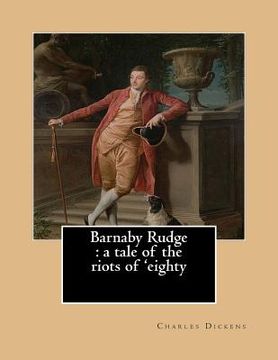Barnaby Rudge: a tale of the riots of 'eighty.By: Charles Dickens, illustraed By: George Cattermole (10 August 1800 - 24 July 1868) E (en Inglés)
Reseña del libro "Barnaby Rudge: a tale of the riots of 'eighty.By: Charles Dickens, illustraed By: George Cattermole (10 August 1800 - 24 July 1868) E (en Inglés)"
Barnaby Rudge: A Tale of the Riots of Eighty (commonly known as Barnaby Rudge) is a historical novel by British novelist Charles Dickens. Barnaby Rudge was one of two novels (the other was The Old Curiosity Shop) that Dickens published in his short-lived (1840-1841) weekly serial Master Humphrey's Clock. Barnaby Rudge is largely set during the Gordon Riots of 1780. Barnaby Rudge was the fifth of Dickens' novels to be published. It had originally been planned to appear as his first, but changes of publisher led to many delays, and it first appeared in serial form in the Clock from February to November 1841. It was Dickens' first historical novel. His only other is the much later A Tale of Two Cities, also set in revolutionary times. It is one of his less popular novels[3] and has rarely been adapted for film or television. The last production was a 1960 BBC production; prior to that, silent films were made in 1911 and 1915. Gathered round the fire at the Maypole Inn, in the village of Chigwell, on an evening of foul weather in the year 1775, are John Willet, proprietor of the Maypole, and his three cronies. One of the three, Solomon Daisy, tells an ill-kempt stranger at the inn a well-known local tale of the murder of Reuben Haredale which had occurred 22 years ago that very day. Reuben had been the owner of the Warren, a local estate which is now the residence of Geoffrey, the deceased Reuben's brother, and Geoffrey's niece, Reuben's daughter Emma Haredale. After the murder, Reuben's gardener and steward went missing and were suspects in the crime. A body was later found and identified as that of the steward, so the gardener was assumed to be the murderer. Joe Willet, son of the Maypole proprietor, quarrels with his father because John treats 20-year-old Joe as a child. Finally having had enough of this ill treatment, Joe leaves the Maypole and goes for a soldier, stopping to say goodbye to the woman he loves, Dolly Varden, daughter of London locksmith Gabriel Varden. Meanwhile, Edward Chester is in love with Emma Haredale. Both Edward's father, John Chester, and Emma's uncle, the Catholic Geoffrey Haredale - these two are sworn enemies - oppose the union after Sir John untruthfully convinces Geoffrey that Edward's intentions are dishonourable. Sir John intends to marry Edward to a woman with a rich inheritance, to support John's expensive lifestyle and to pay off his debtors. Edward quarrels with his father and leaves home for the West Indies. Barnaby Rudge, a simpleton, wanders in and out of the story with his pet raven, Grip. Barnaby's mother begins to receive visits from the ill-kempt stranger, whom she feels compelled to protect. She later gives up the annuity she had been receiving from Geoffrey Haredale and, without explanation, takes Barnaby and leaves the city hoping to escape the unwanted visitor. The story advances five years to a wintry evening in early 1780. On the 27th anniversary of Reuben Haredale's murder, Soloman Daisy, winding the bell tower clock, sees a ghost in the churchyard. He reports this hair-raising event to his friends at the Maypole, and John Willet decides that Geoffrey Haredale should hear the story. He departs in a winter storm taking Hugh, hostler of the Maypole, as a guide. On the way back to the Maypole, John and Hugh are met by three men seeking the way to London. Finding that London is still 13 miles off, the men seek refuge for the night. Beds are prepared for them at the Maypole....... Hablot Knight Browne (10 July 1815 - 8 July 1882) was an English artist. Well-known by his pen name, Phiz, he illustrated books by Charles Dickens, Charles Lever, and Harrison Ainsworth.... George Cattermole (10 August 1800 - 24 July 1868) was an English painter and illustrator, chiefly in watercolours. He was a friend of Charles Dickens and many other literary and artistic figures....
Charles Dickens (1812-1870) nació en Portsmouth y era el primogénito varón de un funcionario de la Armada Real. A los doce años, el encarcelamiento de su padre por deudas lo obligó a ponerse a trabajar en una fábrica de betún. Su educación fue irregular: aprendió por su cuenta taquigrafía, trabajó como ayudante en el bufete de un abogado y finalmente fue corresponsal parlamentario del Morning Chronicle. Sus artículos, luego recogidos en Escenas de la vida de Londres por «Boz» (1836-1837), tuvieron gran éxito y, con la aparición en 1837 de Los papeles póstumos del Club Pickwick, Dickens se convirtió en un auténtico fenómeno editorial. Novelas como Oliver Twist (1837-1839), Nicholas Nickleby (1838-1839) o Barnaby Rudge (1841) alcanzaron enorme popularidad, así como algunas crónicas de viajes, como Estampas de Italia (1846). Con Dombey e hijo (1846-1848) inició su época de madurez, de la que son buenos ejemplos David Copperfield (1849-1850), su primera novela en primera persona y su favorita, en la que desarrolló algunos episodios autobiográficos; La Casa lúgubre (1852-1853); La pequeña Dorrit (1855-1857), Historia de dos ciudades (1859), Grandes esperanzas (1860-1861) y Nuestro amigo común (1864-1865). Murió en Gad's Hill, su casa de campo en Higham, en el condado de Kent.
Ver más
Ver menos

